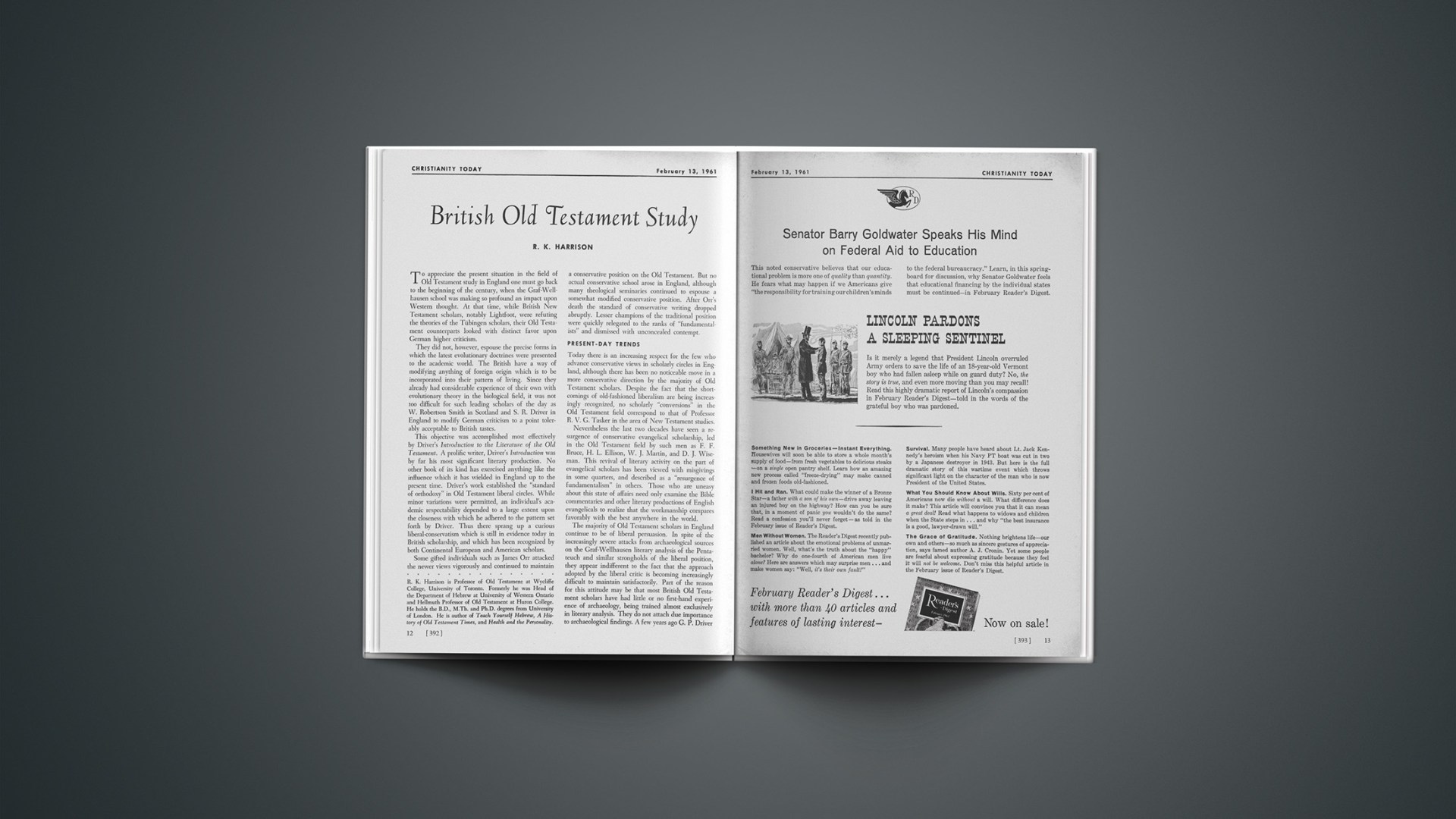To appreciate the present situation in the field of Old Testament study in England one must go back to the beginning of the century, when the Graf-Wellhausen school was making so profound an impact upon Western thought. At that time, while British New Testament scholars, notably Lightfoot, were refuting the theories of the Tübingen scholars, their Old Testament counterparts looked with distinct favor upon German higher criticism.
They did not, however, espouse the precise forms in which the latest evolutionary doctrines were presented to the academic world. The British have a way of modifying anything of foreign origin which is to be incorporated into their pattern of living. Since they already had considerable experience of their own with evolutionary theory in the biological field, it was not too difficult for such leading scholars of the day as W. Robertson Smith in Scotland and S. R. Driver in England to modify German criticism to a point tolerably acceptable to British tastes.
This objective was accomplished most effectively by Driver’s Introduction to the Literature of the Old Testament. A prolific writer, Driver’s Introduction was by far his most significant literary production. No other book of its kind has exercised anything like the influence which it has wielded in England up to the present time. Driver’s work established the “standard of orthodoxy” in Old Testament liberal circles. While minor variations were permitted, an individual’s academic respectability depended to a large extent upon the closeness with which he adhered to the pattern set forth by Driver. Thus there sprang up a curious liberal-conservatism which is still in evidence today in British scholarship, and which has been recognized by both Continental European and American scholars.
Some gifted individuals such as James Orr attacked the newer views vigorously and continued to maintain a conservative position on the Old Testament. But no actual conservative school arose in England, although many theological seminaries continued to espouse a somewhat modified conservative position. After Orr’s death the standard of conservative writing dropped abruptly. Lesser champions of the traditional position were quickly relegated to the ranks of “fundamentalists” and dismissed with unconcealed contempt.
PRESENT-DAY TRENDS
Today there is an increasing respect for the few who advance conservative views in scholarly circles in England, although there has been no noticeable move in a more conservative direction by the majority of Old Testament scholars. Despite the fact that the shortcomings of old-fashioned liberalism are being increasingly recognized, no scholarly “conversions” in the Old Testament field correspond to that of Professor R. V. G. Tasker in the area of New Testament studies.
Nevertheless the last two decades have seen a resurgence of conservative evangelical scholarship, led in the Old Testament field by such men as F. F. Bruce, H. L. Ellison, W. J. Martin, and D. J. Wiseman. This revival of literary activity on the part of evangelical scholars has been viewed with misgivings in some quarters, and described as a “resurgence of fundamentalism” in others. Those who are uneasy about this state of affairs need only examine the Bible commentaries and other literary productions of English evangelicals to realize that the workmanship compares favorably with the best anywhere in the world.
The majority of Old Testament scholars in England continue to be of liberal persuasion. In spite of the increasingly severe attacks from archaeological sources on the Graf-Wellhausen literary analysis of the Pentateuch and similar strongholds of the liberal position, they appear indifferent to the fact that the approach adopted by the liberal critic is becoming increasingly difficult to maintain satisfactorily. Part of the reason for this attitude may be that most British Old Testament scholars have had little or no first-hand experience of archaeology, being trained almost exclusively in literary analysis. They do not attach due importance to archaeological findings. A few years ago G. P. Driver disputed the dating assigned by Albright, Burrows, and others to the early Dead Sea manuscript discoveries. While he did not go to the extreme position adopted by Zeitlin, Driver dated the material several centuries after the beginning of the Christian era. If certain reports are to be believed, one of his principal reasons for rejecting the Maccabean era date of some of the scrolls was that his father’s eloquent demonstration of a Maccabean date for the Book of Daniel would thereby be gravely undermined. Driver is primarily a philologist, and from this standpoint he viewed the material from Qumran. He continued to discount the significance of the archaeological evidence despite the insistence of American and British scholars. Only when the cumulative weight of archaeological discoveries demonstrated beyond any reasonable doubt the untenability of his position did he adopt a dating considerably nearer the beginning of the Christian period.
Apart from a very few individuals such as S. H. Hooke and H. H. Rowley, British Old Testament scholare have not been conspicuous for their originality of thought or presentation of subject matter. Rightly or wrongly, my countrymen are more influenced by ideologies than many of them care to admit, and this is particularly noticeable in the area of Old Testament studies. Consequently British writings in this field often reflect a close, frequently uncritical, adherence to trends of thought in circulation on the Continent. Where some of these might appear inimical to the conservatism of British liberal scholarship they are either repudiated as reactionary by the nervous, or modified to suit the local taste by the more resolute.
This harking back to the traditional delineation of the situation is a curious phenomenon to say the least. Its most recent manifestation occurred in a book by Professor G. W. Anderson of Durham titled A Critical Introduction to the Old Testament (Duckworth, 1959). This work is a careful and judicious survey of critical orthodoxy, and furnishes good summaries of the positions adopted by the Scandinavians as well as the views maintained by older scholars such as Welch, Kennet, and Volz. However, the author concluded his survey by finding recent theories deficient in one way or another, and expressed a decided preference for the views advanced by Driver in 1891, which, one would judge, he regarded as definitive.
Pertinent to this general situation is the fact that Driver’s Introduction has recently been issued in paperback form under a well-known imprint. My first reaction was one of pleasure in seeing the title of the book superimposed upon a fragment of a Qumran scroll. My delight was speedily dispelled, however, when I discovered that the contents were virtually unchanged from the 1897 edition. A preface contained the statement that archaeology had revealed nothing which was in conflict with the generally accepted conclusions of critical scholars. While this remark may have been true in 1897, the situation today is vastly different, and the person who picks up this classic document in its new cover may be beguiled, at least temporarily, into thinking that this comment represents the consensus of up-to-date opinion.
ENCOURAGING TURN
When Edward Robertson was Professor of Semitics in Manchester he took serious issue with the Graf-Wellhausen position, and wrote at some length on the subject. While his views differed somewhat from the conservative position, his standpoint was a welcome change from the dull, unimaginative productions of his contemporaries. Robertson’s views were reflected in part in a work by one of his students, R. Brinker, dealing with the influence of sanctuaries in early Israel.
This work broke new ground in showing that the testimony of the Samaritan Pentateuch was fatal to the Graf-Wellhausen theory. However, it was oriented strictly in terms of literary criticism, and failed to take any cognizance of contemporary archaeological discoveries. How anyone can discuss pre-exilic Israelite religious institutions without any reference to Ugaritic culture is beyond this writer’s understanding.
Brinker’s book was written in 1946, and it could be argued in charity that the war had prevented the author from drawing upon the work of European archaeologists to any extent. However, I had graduated three years before the book appeared in print, and I clearly remember reading extensively about the discoveries at Ras Shamra while I was a student. Quite obviously Brinker had no appreciation of the significance which archaeology has for modern discussions of the critical hypothesis. His select bibliography does not include the work of one modern archaeologist. Eclectic scholarship of this kind is just not good enough, however well-intentioned it may be.
The most attractive product of recent British scholarship is the N. H. Snaith edition of the Old Testament in Hebrew, published in 1958 by the British and Foreign Bible Society. Snaith began work in 1933 on a text to replace the Society’s Letteris edition of 1866, and he drew considerably on Spanish Hebrew manuscripts in an attempt to represent the true Masoretic text of Ben Asher. The resultant product agrees closely with the researches of Professor Paul Kahle, who edited the text of the third edition of the Kittel Bible, published in 1937. The Snaith text follows the Masoretic traditions as to spacing, notes, Sedarim and Haftaroth, the result of which has been to furnish the student with an attractive and serviceable Hebrew text which enshrines the diligence and application characteristic of British scholarship.
Samuel M. Shoemaker is the author of a number of popular books and the gifted Rector of Calvary Episcopal Church in Pittsburgh. He is known for his effective leadership of laymen and his deeply spiritual approach to all vital issues.










